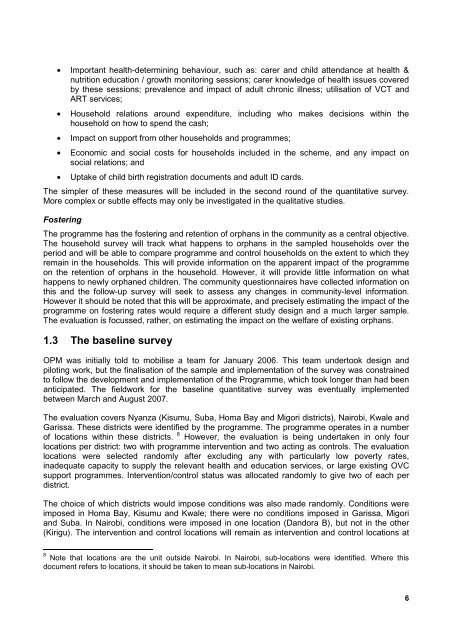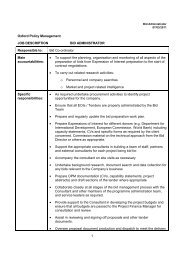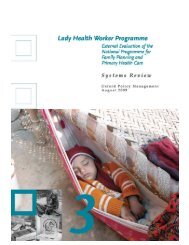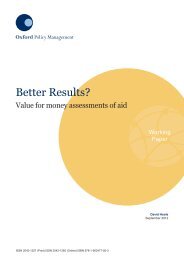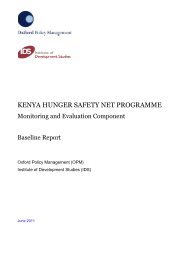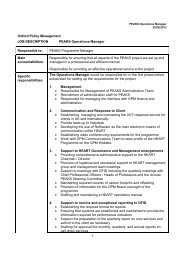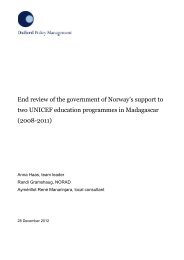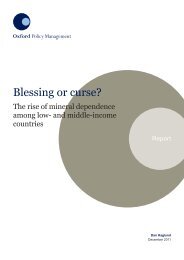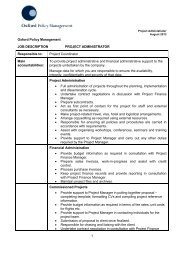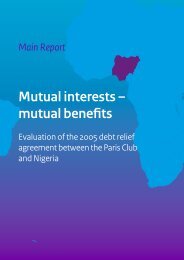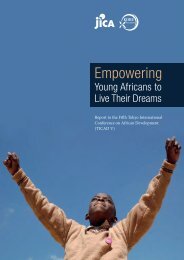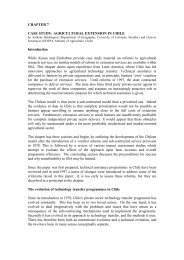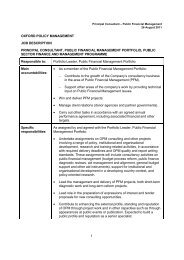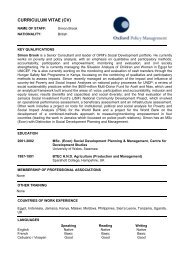Kenya OVC-CT Programme Operational and Impact Evaluation
Kenya OVC-CT Programme Operational and Impact Evaluation
Kenya OVC-CT Programme Operational and Impact Evaluation
Create successful ePaper yourself
Turn your PDF publications into a flip-book with our unique Google optimized e-Paper software.
• Important health-determining behaviour, such as: carer <strong>and</strong> child attendance at health &nutrition education / growth monitoring sessions; carer knowledge of health issues coveredby these sessions; prevalence <strong>and</strong> impact of adult chronic illness; utilisation of V<strong>CT</strong> <strong>and</strong>ART services;• Household relations around expenditure, including who makes decisions within thehousehold on how to spend the cash;• <strong>Impact</strong> on support from other households <strong>and</strong> programmes;• Economic <strong>and</strong> social costs for households included in the scheme, <strong>and</strong> any impact onsocial relations; <strong>and</strong>• Uptake of child birth registration documents <strong>and</strong> adult ID cards.The simpler of these measures will be included in the second round of the quantitative survey.More complex or subtle effects may only be investigated in the qualitative studies.FosteringThe programme has the fostering <strong>and</strong> retention of orphans in the community as a central objective.The household survey will track what happens to orphans in the sampled households over theperiod <strong>and</strong> will be able to compare programme <strong>and</strong> control households on the extent to which theyremain in the households. This will provide information on the apparent impact of the programmeon the retention of orphans in the household. However, it will provide little information on whathappens to newly orphaned children. The community questionnaires have collected information onthis <strong>and</strong> the follow-up survey will seek to assess any changes in community-level information.However it should be noted that this will be approximate, <strong>and</strong> precisely estimating the impact of theprogramme on fostering rates would require a different study design <strong>and</strong> a much larger sample.The evaluation is focussed, rather, on estimating the impact on the welfare of existing orphans.1.3 The baseline surveyOPM was initially told to mobilise a team for January 2006. This team undertook design <strong>and</strong>piloting work, but the finalisation of the sample <strong>and</strong> implementation of the survey was constrainedto follow the development <strong>and</strong> implementation of the <strong>Programme</strong>, which took longer than had beenanticipated. The fieldwork for the baseline quantitative survey was eventually implementedbetween March <strong>and</strong> August 2007.The evaluation covers Nyanza (Kisumu, Suba, Homa Bay <strong>and</strong> Migori districts), Nairobi, Kwale <strong>and</strong>Garissa. These districts were identified by the programme. The programme operates in a numberof locations within these districts. 8 However, the evaluation is being undertaken in only fourlocations per district: two with programme intervention <strong>and</strong> two acting as controls. The evaluationlocations were selected r<strong>and</strong>omly after excluding any with particularly low poverty rates,inadequate capacity to supply the relevant health <strong>and</strong> education services, or large existing <strong>OVC</strong>support programmes. Intervention/control status was allocated r<strong>and</strong>omly to give two of each perdistrict.The choice of which districts would impose conditions was also made r<strong>and</strong>omly. Conditions wereimposed in Homa Bay, Kisumu <strong>and</strong> Kwale; there were no conditions imposed in Garissa, Migori<strong>and</strong> Suba. In Nairobi, conditions were imposed in one location (D<strong>and</strong>ora B), but not in the other(Kirigu). The intervention <strong>and</strong> control locations will remain as intervention <strong>and</strong> control locations at8 Note that locations are the unit outside Nairobi. In Nairobi, sub-locations were identified. Where thisdocument refers to locations, it should be taken to mean sub-locations in Nairobi.6


